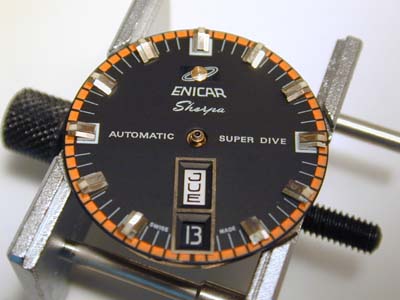The Dial and Day-Date Works

The Enicar 167 is a day-date movement, with a nicely stacked arrangement at 6 o'clock. The day-of-the-week wheel on this particular example is in Spanish; the dial has a very nice balance to it - the day-date windows provide balance to the logo with applied brass "planet", while the other dial wording keeps clutter to a minimum along the 3-9 axis. The dial is affixed by two screws set into the rim of the movement bottom plate, the usual location. Removing it reveals the following:


The dial itself is made of painted brass; the base uses a well-executed matte black finish with printed white and orange; the reverse side shows the feet for the applied markers (a), the brass planet for the logo (b), the feet which secure the dial to the movement (c), and what appears to be an inconsequential goof in the location of the two holes for the dial feet (d). Unfortunately, the applied markers appear to be made of chromed plastic - this watch appears to have been made before the discovery that plastic is tacky. Overall, the workmanship appears to be of good quality, even if not intended to be competitive with the high-end.
The underdial work which is exposed by removal of the dial initially appears to be very typical:

The printing of the day wheel allowed this movement to be used with day windows in a variety of positions; there is clearly enough room for the day to be printed vertically at 6 o'clock, as in this watch, as well as horizontally at both 3 o'clock and 6 o'clock. As with the dial, both the date and day wheels are made of brass, with high quality printing - these assemblies are sometimes made with plastic on typical high-volume production watch today.
Removing the day wheel exposes the works for the day and date mechanism:

The hour wheel for the movement (a) drives an intermediate wheel (b), which has three sets of gears affixed to it - two small gears of the same size sandwiched around a larger diameter gear. The two smaller gears drive the day advance wheel (c) and the date advance wheel (d) at the same rate to achieve a once-per-day advancement for both wheels. The other side of the movement has the detent for the day wheel (e), which is made of an unusually large polished steel arm with a separate wire spring. Both the day and date advance wheel can be moved safely forward or backwards through midnight without damage to the works.
Removing these components, along with the suitably finished steel cover plates for the date mechanism, reveals the keyless works and the unique quickset date mechanism.

Like the day wheel, the date wheel detent spring (a, above) is a nicely constructed machined assembly of polished steel, with a separate wire spring for tensioning. Today's typical mass-produced movements use flat stamped pieces or even simple wire springs with a "v" bent into the end to perform these same functions, at reduced cost and elegance. The cover plate for the keyless works (b, above) nicely integrates a detent spring and hold-down fingers for various keyless works components. Among these is an arm (c, above) which is responsible for the very unusual means for quick setting of the date wheel, along with its detent spring (d, above).

A closeup of this area reveals how this mechanism works: when the crown is pulled out all the way, the standard pull-out piece (a) moves with the stem (red arrow). In addition to moving the clutch to engage the hands-setting mechanism, it also causes arm (b) to rotate as indicated. This in turn carries an advance finger (c) into contact with a recoil spring (d), which moves the tip of the advance finger into contact with one of the teeth on the date ring (not shown). When the crown is pushed back in, the pieces all move back into their original position, while simultaneously the advance finger causes the date ring to move to the next date.
Thus, to set the date on this watch, one pulls out the crown to the timesetting position, and then moves the hands back-and-forth through midnight until the correct day of the week shows in the day window. Then, the correct time is set. Once here, the crown is repeatedly pulled out and pushed in until the correct day of the month shows in the date window. As the watch has no hack feature, there movement continues to run while the quick-set date is being fussed with.
As mentioned earlier, quirky does not equate to good. This particular quick-set ultimately fails in my opinion, as it is very difficult for the operator of the watch to set the time without inadvertently advancing the date. Thus, a simple correction of the time can very easily turn into a Keystone Kops exercise in date setting.

The final part of this article will take a quick glance at the top-plate of this movement, and compare it with its "younger brother", the Chronoswiss Cal. 122.
All Rights Reserved